Bike companies spend months finessing the details of their kids’ models – the scaled-down brake levers, mini cranks, a child-friendly low centre of gravity. And what are the children most impressed by? A set of toy plastic cones.
That, along with the apparently great significance of rear-wheel skids to the lives of six-year-olds, was among the lessons learned from a fun if exhausting morning trying out children’s bikes with a collection of fun-sized testers.
The cheapest of the machines, Halfords’ £70 Apollo Police Patrol, comes with a box at the rear, inside which are three orange cones. On discovering this our team – my five-year-old son and a collection of friends – immediately set about coning off various adults and decreeing them under arrest.
Great fun as this is, there are other factors to consider if you’re thinking of buying a kids’ bike ahead of Christmas.
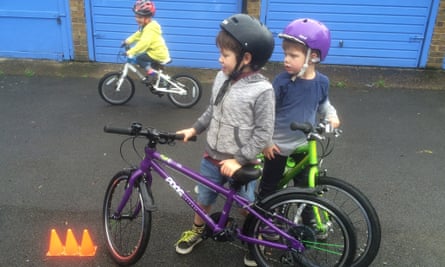
Traditionally, most such bicycles were built to appeal to, well, kids. They often had police logos, or superhero tie-ins, or pink ribbons. Adults were mainly interested in the price. Then, 10 years ago, came Islabikes, the Shropshire-based purveyor of more pricey but better-built children’s bicycles, along with a series of similar marques. Their bikes had smaller versions of the sort of components familiar to bike-riding mums or dads, like V-brakes. They were light, making them easier for younger children to master and – almost equally important – easier for parents to carry home from the park when tiredness set in.
My plan was to try two of the cheaper, more traditional type, and two of the latter sort. However, Decathlon’s valiant attempts to send me a Liloo Princess bike (yes, with that name it is pink; it even has a doll carrier) were foiled by DHL. So we brought in a Frog bike, another posher model, albeit cheaper than some.
Two of the bikes were aimed at beginner riders, with 14in or 16in wheels and a single speed drivetrain. Two were the next step up, featuring gears and 20in wheels. Prices ranged from £70 to north of £300. The latter is a fair bit for a children’s bike, although it’s worth remembering that second-hand values hold up well.
All in all, it can seem a lot to think about, but one factor above all is worth bearing in mind: so long as the parents can afford it and the child can ride it (or learn to ride it), more or less any bike brings endless, boundless joy. Whether it’s chosen because the parents think the brakes are well designed, or the child loves the tiny plastic cones, should hopefully matter little.
Halfords Apollo Police Patrol: £69.99
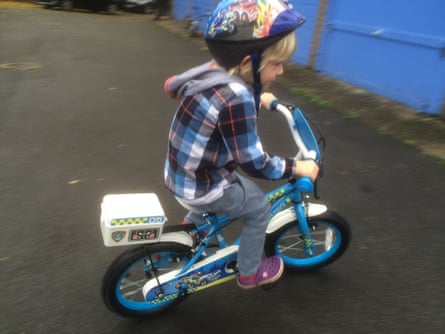
Aimed at children from four up, this was officially the smallest bike on test with its 14in wheels. That said, the 16in Hoy, with a more sloped frame, was almost easier for the younger kids to climb aboard. The Apollo was both the cheapest of the test bikes and the heaviest, at a hefty 9.8kg.
It’s certainly eye-catching, covered with police logos, including a clip-on plastic “handlebar plaque”, not to mention those sought-after cones. It was the only bike to come with stabilisers, though these were easily removed.
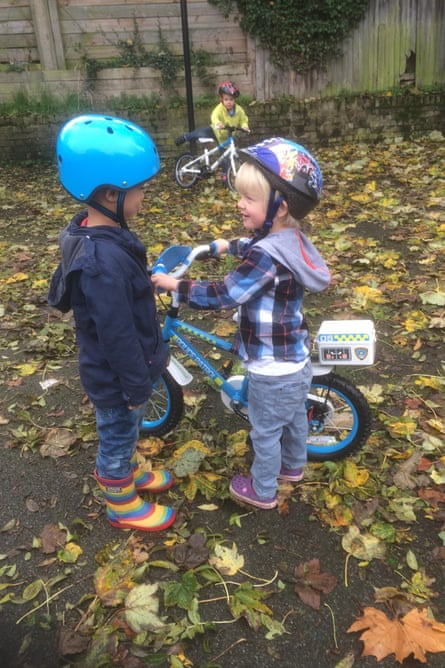
The Apollo was arguably the most argued-over bike among our testers, and they all found it easy to ride, even if the weight meant a couple of the smaller ones struggled noticeably to pedal it up even a shallow incline. The caliper brakes worked fine, but are noticeably less powerful than the other bikes’ V-brakes, and might prove fiddly to adjust.
Testers’ verdicts:
Jack, four: “I like it because I like policemen. They are my favourite emergency service.”
Jacob, four: “It goes fast. But my bike goes even faster.”
Missy, four: [putting cones around an adult] “You’re under arrest!”
Hoy Bonaly 16in: £240
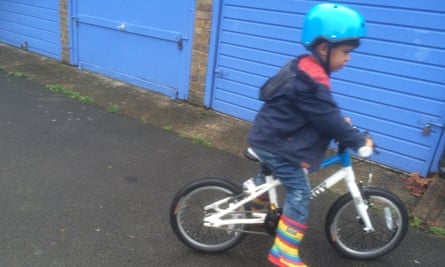
Named after the hills south-west of Edinburgh where the eponymous Sir Chris Hoy first mountain biked – it’s not, as one parent surmised, an obscure Polari slang term – the Bonaly is, as with all Hoy bikes, sold only in Evans shops.
Just £10 cheaper than the equivalent Islabike model it’s clearly aimed at a similar market, that is, one where the parents make the main buying decision, not least as the Hoy name probably isn’t much of a draw for four-year-olds.
This is definitely a well-made bike, light (6.3kg) and nippy, with mini V-brakes and, as mentioned above, a sloped top-tube allowing our smaller testers, who usually ride 14in-wheeled bikes, to get the saddle sufficiently low.
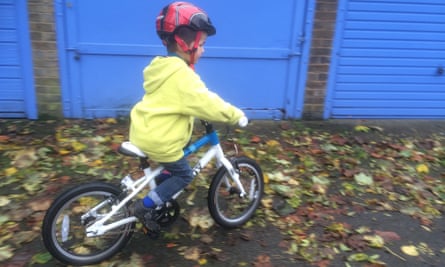
The company says the short cranks and sloped fork make for a low centre of gravity, keeping the bike stable. Certainly, all the children were soon whizzing about at speed, and there was a fair bit of competition to ride it.
Testers’ verdicts:
Elvis, four: “This is my favourite. It’s got a bell and it’s got a light. [pointing to the reflector]”
Jacob, four: “I like the colour. And it goes really fast.”
Isaac, six: “It’s fun to ride, but the brakes aren’t very good.”
Frog 52: £250
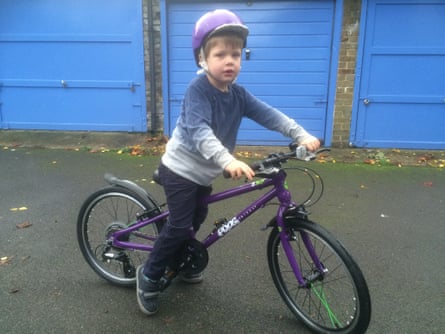
This 20in-wheeled bike, with eight gears, is the next step up in kids’ machines and officially aimed at those aged five to six, although the steeply-sloped frame meant a couple of the four-year-olds also tried it.
Unlike Islabikes, which are mail order only, Surrey-based Frog sell their machines through independent bike shops, meaning you can try them out. Ours was kindly lent by the very knowledgeable Balfe’s Bikes in East Dulwich, south-east London. The Frog range goes from toddlers’ balance bikes to those big enough for teenagers, and you can even get them in Team Sky colours.
The 52 was an immediate hit, partly the styling and colourful look, with the purple frame and couple of luminous green spokes per wheel, but it also proved hugely easy to ride, even for those who could barely get a leg over the top tube. It’s well kitted-out, coming as standard with a bell, reflectors and mudguards, and with two sets of tyres, smooth for on-the-road and knobbly. It even has mounts for a rack.
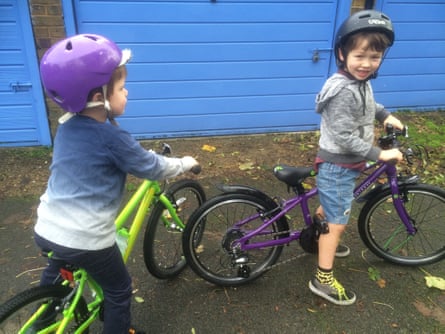
It’s in more or less direct competition with Islabikes’ Beinn (see below), and while the Frog is almost a kilo heavier at 8.75kg, it’s also £80 cheaper. Some Frog dealers also run a scheme, LeapFrog, where outgrown models can be part-traded in for the next size up.
If there is one criticism of the Frog, the thumb shifter gear system can be a bit of a struggle for smaller hands, certainly more so than the gripshift on the Islabike.
Testers’ verdicts:
Ralph, five: “It’s really fast! And I like this green thing [the Frog logo on the frame].”
Isaac, six: “The brakes are rubbish – you can’t do a skid on it.”
Elvis, five: “Purple is my favourite colour.”
Islabike Beinn 20 Small: £329.99
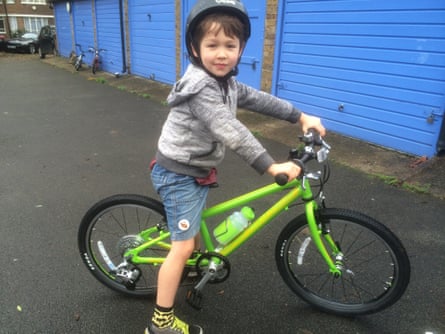
This was something of a double-test. Islabike opted to send the smaller version of its second-stage pedal bike in part because my son already has (and loves) the next Islabike down, the equally hard-to-pronounce Cnoc. In fact, five of the six testers usually ride a Cnoc.
The Cnoc, which comes in 14in and 16in versions, isn’t cheap at £250, but is very light (6.1kg) and beautifully made, with a fully-enclosed chain (the one pictured below is an older model and so doesn’t have this) and adjustable handlebars. It’s also a great bike to learn to ride on. Our youngest tester, Elvis, struggled to learn to cycle for a few months on a heavier bike before his parents traded it for a Cnoc 14. He then mastered riding in about a day.
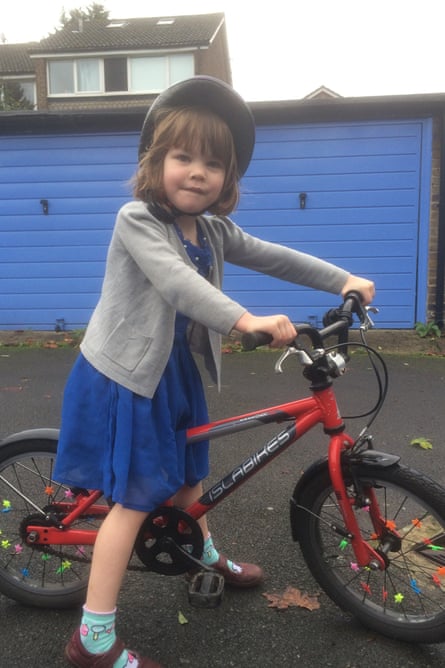
The Beinn (which I spent days misreading as Benin, wondering what west Africa had to do with kids’ bikes) has seven gears, changed with a gripshift system. My five-year-old, Ralph, was a newcomer to gears but mastered it pretty quickly, soon delighting in the fact that more gears means you can cycle at greater speed.
It’s beautifully shiny – our test model came in a shimmering, two-tone green – something not to be underestimated as a draw for small children, and light, at 7.8kg. It also has rack mounts. It was enormously popular among the two testers big enough to ride it, Ralph and Isaac, possibly more so than the Frog.
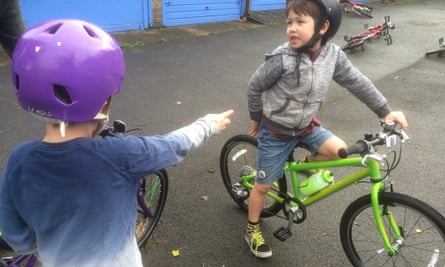
And yes, £330 is a lot for a small child’s bike. But bear in mind that the second-hand value holds up well – they often sell used for £250.
Testers’ verdicts:
Missy, four (riding a Cnoc): “This is the same as my bike. I love it.”
Ralph, five: “I like you can go really fast on it. I like that thing [the gears] and the water bottle.”
Isaac, six: “You can do really good skids on it.”
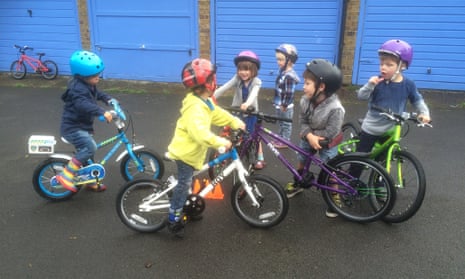
Comments (…)
Sign in or create your Guardian account to join the discussion